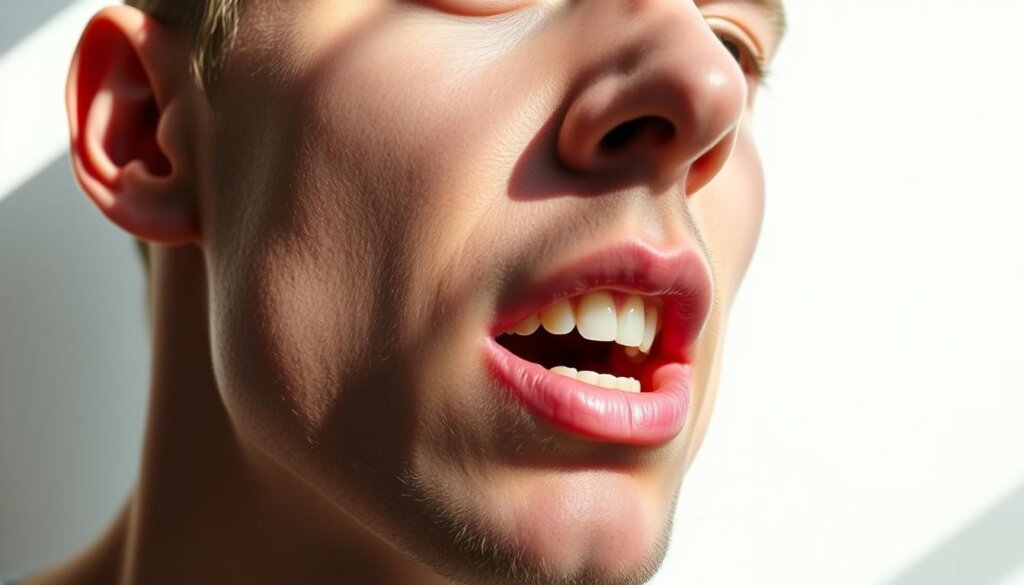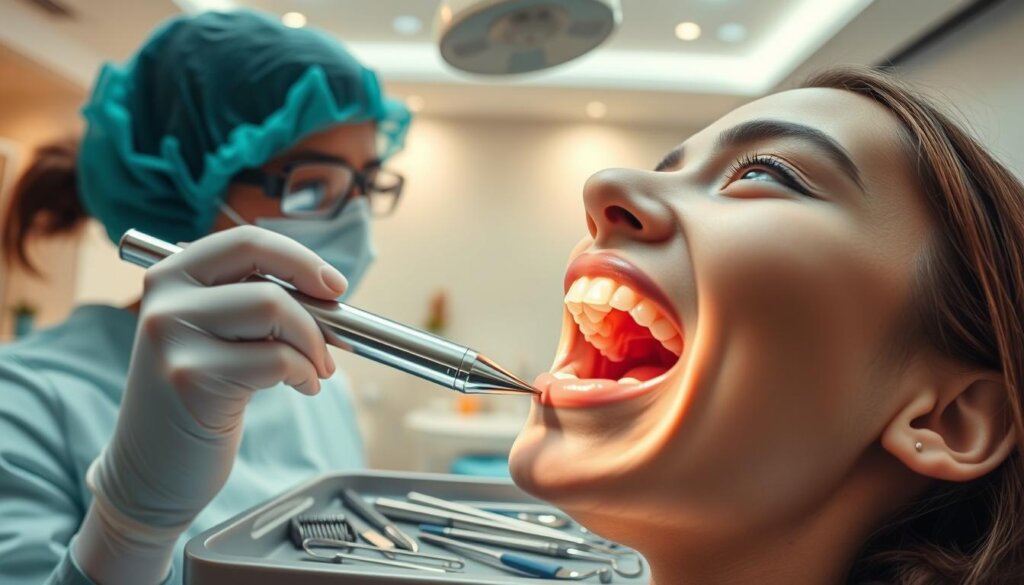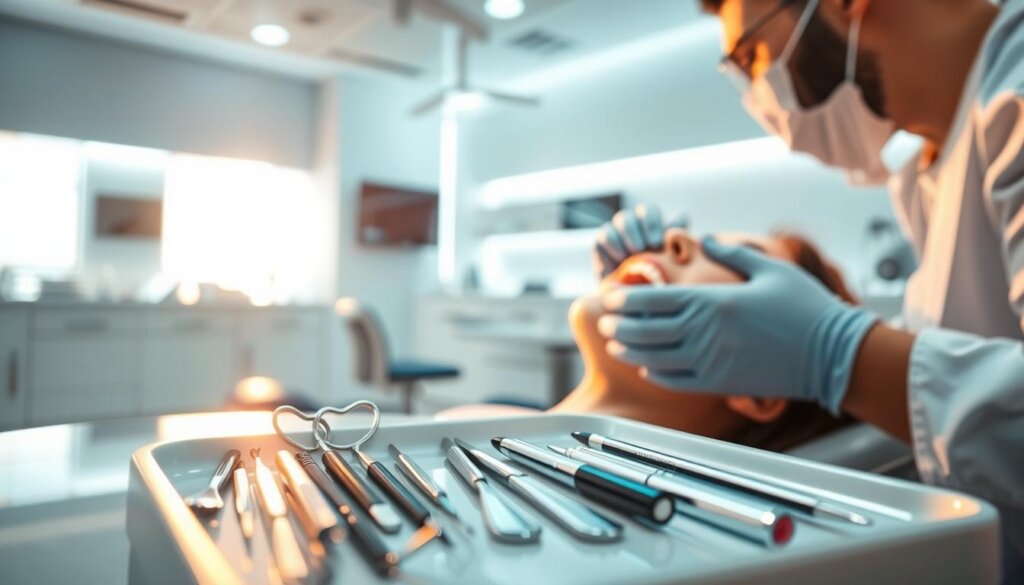Can a Dental Cleaning Cure Bad Breath?
What if fresh breath comes not from a mint, but from your hygienist’s tools? This idea makes us rethink our solutions for bad breath.
Dental cleanings might not just mask bad breath, but could actually fight its causes. According to Mayo Clinic and Cleveland Clinic, cleanings remove harmful build-up. They get rid of plaque, tartar, and bacteria that cause bad smells. These cleanings also lessen gum swelling and areas where smelly sulfur compounds are.
But, can they really “cure” bad breath? The answer depends on what’s causing it. If bad breath comes from sinus problems, certain medications, or acid reflux, then defeating it requires medical help too. Normally, dental cleanings are most effective when they’re part of a bigger plan. This plan should include routine oral care and changes in habits for continuously fresh breath.
Key Takeaways
- Professional cleanings remove plaque, tartar, and biofilm that harbor odor-causing bacteria.
- Gum health improves after cleanings, lowering volatile sulfur compound production.
- A dental cleaning for bad breath helps most when oral sources are the main cause.
- True halitosis treatment may require medical evaluation for sinus disease, reflux, or xerostomia.
- Daily brushing, interdental cleaning, and tongue care sustain a bad breath remedy between visits.
- Regular checkups personalize care, supporting consistent, fresher breath over time.
Understanding Bad Breath: Causes and Solutions
Bad breath, or halitosis, often starts with bacteria. It’s important to know the causes and how to fight bad breath while keeping your mouth healthy. With the right habits and care, many people can beat bad breath without guessing.
Common Causes of Bad Breath
Most bad breath starts in your mouth. A coated tongue is a cozy place for bacteria that make smelly sulfur compounds. Plaque on your gums, gum disease, and dirty dentures or retainers add to the problem.
When your mouth is dry, it can’t clean itself well. Smoking, drinking, and not drinking enough water make dry mouth worse. Foods like garlic and onions, and too much sugar change your mouth’s bacteria and can make your breath smell worse.
- Intraoral biofilm and tongue coating increase sulfur compound load.
- Plaque-driven inflammation raises bleeding risk and odor intensity.
- Removable appliances trap debris unless cleaned thoroughly.
How Oral Hygiene Affects Breath
Good oral hygiene can stop bad breath by breaking up the biofilm that causes it. Brushing twice a day with fluoride toothpaste and flossing once a day keep your mouth clean. Cleaning your tongue also helps.
Staying hydrated, brushing after meals, and cleaning any dental appliances help fight bad breath daily. These habits stop bacteria from building up.
| Action | Target | Mechanism | Expected Impact |
|---|---|---|---|
| Fluoride toothbrushing (2x/day) | Teeth and gumline | Removes plaque; strengthens enamel | Reduces odor precursors from biofilm |
| Flossing or interdental brushes (1x/day) | Interproximal spaces | Disrupts anaerobic niches | Lowers sulfur compound generation |
| Tongue cleaning (posterior focus) | Back of the tongue | Decreases bacterial load | Addresses a frequent odor source |
| Hydration and saliva support | Whole mouth | Enhances self-cleansing | Mitigates xerostomia-related malodor |
| Appliance care (daily cleaning) | Dentures/retainers | Removes debris and plaque film | Prevents odor reservoirs |
When to Seek Professional Help
If bad breath stays even with good care, it’s time for expert help. Signs include bleeding gums, loose teeth, or trouble with dentures that you can’t fix yourself.
Dentists might use special tests and customize a treatment for you. If your breath might be affected by other health issues, they’ll suggest seeing a doctor to check for those and help get rid of your bad breath.
The Role of Dental Cleanings in Oral Health
Dental care does more than just make teeth shine. It removes biofilm and calms sore gums. It also helps keep the mouth’s natural balance. When people want fresher breath, a professional cleaning can help. It cuts down on bacteria that cause bad smells. This helps protect the mouth’s soft tissues too.
What Happens During a Dental Cleaning?
A trained hygienist does the cleaning. They use a tool called a scaler to get rid of plaque and tartar. These are found above and below the gumline. These deposits are home to bacteria that cause bad smells. Regular toothbrushing can’t always reach these spots. After the scaling, the teeth are polished. This makes them smooth and slows down plaque forming again.
The appointment usually includes flossing. This breaks up plaque between teeth. The hygienist also checks gum pockets closely. This whole process is a professional way to fight bad breath. It’s part of a careful plan to treat halitosis. It also gets patients ready to take good care of their teeth at home.
- Scaling: Removes calcified plaque hiding bacteria that cause odors.
- Polishing: Makes the teeth’s surface smoother which helps prevent plaque forming again.
- Interdental cleaning: Gets rid of bacteria hiding between teeth.
Sometimes, the dentist checks for fillings or crowns that aren’t right anymore. Fixing these helps fight bad breath as well. It makes the effects of a cleaning last longer.
Importance of Regular Cleanings
Having cleanings on a regular schedule is key. It keeps plaque under control and reduces gum swelling. This makes treating bad breath more successful. Having cleanings often stops the mouth from getting too many odor-causing germs. This helps keep breath fresh between visits.
How often you need a cleaning depends on your gum health, medical history, and how you care for your teeth at home. With regular cleanings, your dentist can keep an eye on gum health. They can offer advice and step in early if small issues start turning into big ones.
- Less tartar means healthier gums.
- Finding problems early stops them from getting worse.
- Improving how you clean your teeth at home means better breath.
Combined with personal advice, dental cleanings become a key part of home care. They help manage halitosis effectively and support overall oral health in the long run.
How Dental Cleanings Address Bad Breath
Doctors fight bad breath by tackling the bacteria that cause it. They ask: Can a cleaning fix bad breath? Clinical steps aim at the main sources of bad smells. This helps get rid of bad breath caused by buildup and swelling.
Removal of Plaque and Tartar
The hygienist uses tools to break up harmful layers under the gums. These layers give off smelly sulfur gases. Regular brushing can’t get rid of hard tartar; a professional cleaning can.
Clearing away these deposits lets oxygen in, leading to less smell. For many, this science-supported step is a real answer to bad breath. It deals with the cause, not just the symptom.
Impact on Gum Health
Gum swelling and pockets offer hiding spots for smelly bacteria. Cleaning these out reduces bacteria, stops bleeding, and shrinks pockets. If deeper issues are found, they’ll suggest more treatment, as recommended by experts like the Mayo Clinic.
This approach also helps stop bad breath from long-term infections. It tackles whether a cleaning can stop bad breath from gum disease. It’s an important first step, along with specific gum treatments.
Uncovering Hidden Issues
The team checks fillings, cavities, and dental devices for problems. Bad fillings and cracks can keep smells lingering. Fixing these issues, and tips on cleaning your tongue and devices, boosts any treatment for bad breath.
Based on these checks, the cleaning is tailored to fight bad breath more effectively. Patients also learn how to take care of their teeth at home. This dual approach aims to fully address bad breath by targeting both the biofilm and its hiding spots.
Importance of Daily Oral Hygiene
Daily care is crucial for fighting bad breath. By following consistent habits, you support a healthy balance of microbes in your mouth and achieve fresher breath. Learning and sticking to evidence-based routines is key, especially after a professional cleaning, for maintaining the gains at home.
Key principle: Combine mechanical cleaning with antimicrobial products and keep your tools in top shape. You should replace a worn-out toothbrush every 3–4 months for the best results.
Brushing Techniques for Fresh Breath
Use fluoride toothpaste and brush at least two times a day, after meals if possible. Brush gently with short strokes, angled at 45 degrees to your gums. This removes the plaque that otherwise produces smelly sulfur compounds. Antibacterial toothpaste can help reduce plaque and bad breath.
Don’t forget your tongue. Smokers or those with dry mouth often get a coated tongue that smells bad. Clean it with a soft brush or a scraper, then rinse well. This, along with good brushing, really helps keep your breath fresh.
- Brush for two minutes, covering all areas of your teeth
- Pay extra attention to the back of your tongue and your molars
- Clean bridges, dentures, retainers, and mouth guards daily to prevent smells
Flossing to Combat Bad Odor
Floss daily to remove plaque and food that your brush can’t get to. This helps reduce the bad smells that come from bacterial decay. Flossing is proven to fight bad breath effectively over time.
- Use the floss in a C-shape against each tooth surface
- Gently go below the gumline with the floss
- Try interdental brushes or water flossers if you have tight spaces or bridges
Small, consistent efforts are key to fighting bad breath. They help keep your mouth healthy and your breath fresh all day.
Other Professional Treatments for Bad Breath
Clinicians try other methods when regular care fails. These methods reduce bacteria, boost saliva, and help gums stay healthy. Alongside teeth cleaning, they offer solid solutions for bad breath. Each plan is carefully made to treat halitosis well.
Antimicrobial Mouth Rinses
Dentists might suggest special mouth rinses to fight odor-causing bacteria and break down plaque. Adding toothpastes with germ-fighting ingredients helps keep breath fresh between dental visits.
- Chlorhexidine or cetylpyridinium formulations reduce volatile sulfur compounds.
- Short, supervised courses limit staining risk while improving breath metrics.
- Combined with professional teeth cleaning for bad breath, outcomes often improve faster.
Treatment for Gum Disease
Bad breath germs love to hide in periodontal pockets. Cleaning below the gumline helps, and sometimes a periodontist is needed for serious cases.
- Professional debridement reaches niches that brushing and flossing miss.
- Adjusting faulty fillings removes sheltered sites that trap bacteria.
- This structured halitosis treatment aligns with evidence-based protocols for a lasting bad breath remedy.
Addressing Dry Mouth Conditions
Dry mouth can make bad breath worse by lowering natural cleaning. Improving saliva flow helps fight off bad breath by washing away odors and neutralizing acids.
- Hydration strategies and limiting alcohol, caffeine, and tobacco protect saliva.
- Sugar-free gum or xylitol lozenges stimulate salivary glands and reduce plaque acids.
- For persistent symptoms, clinicians may recommend saliva substitutes or prescribe sialogogues.
Together with teeth cleaning, these steps form an effective treatment plan for bad breath. This approach targets the root causes instead of just hiding the problem. It’s a scientifically-supported way to cure bad breath.
Dietary Impact on Bad Breath
What you eat affects your mouth’s bacteria and the smell of your breath. Choosing the right foods can help fight bad breath. It reduces the elements that make bacteria create sulfur smells. This approach is a simple way to freshen breath without making daily life hard.
Foods that Cause Bad Breath
Onions and garlic are full of compounds that can make your breath smell. They release sulfur that leaves through your breath. Sugary foods help bad bacteria grow, causing more bad smells. Protein bits stuck in teeth can also lead to worse odors.
- Trigger aromatics: raw garlic, onions, scallions, and shallots
- Fermentable sugars: candy, sweetened coffee, soda, and pastries
- Stagnant proteins: cured meats, jerky, and leftover food debris
To end bad breath, eat fewer strong-smelling foods before events. Pair meat with veggies and drink water after sweets. This pattern helps fight bad breath and keeps eating enjoyable.
Breath-Freshening Foods and Drinks
Drinking water keeps your mouth clean. It helps wash away food bits and balances your mouth’s pH. Chewing sugar-free gum or mints with xylitol boosts saliva. This helps fight bad breath in a lasting way.
- Hydrators: water, unsweetened herbal tea
- Saliva boosters: xylitol gum or mints from brands like Trident and Spry
- Fiber scrubs: apples, celery, carrots, and leafy greens
- Polyphenol allies: green tea and parsley for short-term odor control
Make meals that lower sugar and increase water throughout the day. Add crunchy veggies to lean meats to keep teeth clean. Chew xylitol gum after small bites. These steps will help maintain fresh breath between dentist visits.
| Dietary Choice | Mechanism | Suggested Use | Breath Outcome |
|---|---|---|---|
| Onions/Garlic | Volatile sulfur compounds exhaled via lungs | Limit before social events; cook to mellow impact | May intensify odor temporarily |
| Sugary Drinks | Feeds acidogenic bacteria; lowers oral pH | Swap for water or unsweetened tea | Higher risk of persistent malodor |
| Lean Protein + Fiber | Reduces residue; fiber aids mechanical cleansing | Pair chicken or tofu with apples or greens | Support for fresher breath |
| Xylitol Gum/Mints | Stimulates saliva; discourages cariogenic flora | Use after meals and snacks | Practical bad breath remedy |
| Water | Rinses debris; maintains moisture | Sip throughout the day | Helps eliminate bad breath cues |
Lifestyle Changes to Improve Breath
Our daily habits impact our mouth’s health. Making small changes can improve saliva flow and reduce bad-smelling bacteria. This makes our breath fresher and our gums stronger.
Quitting Smoking and Tobacco Use
Using tobacco can dry out your mouth and cause more plaque and gum disease. Stopping tobacco use cuts down harmful sulfur compounds. It helps restore a healthy balance in your mouth.
To quit, use nicotine replacement and coaching for support. Instead of smoking, try drinking water and cleaning your tongue. Notice how your taste and morning breath get better. This will help you keep going for fresher breath.
- Set a quit date and remove things that make you want to use tobacco.
- Chew sugar-free gum to keep saliva flowing and fight bad breath.
- Get a professional cleaning to get rid of lingering smells.
Staying Hydrated
Drinking enough water helps your saliva do its job. Saliva washes away food and limits bad breath bacteria. So, staying hydrated is key to keeping your breath fresh.
Here’s how: always have water with you, drink water after coffee or alcohol, and choose sugar-free lozenges. These habits boost your oral health and keep your breath fresh between dental visits.
- Make sure to drink water all day, not just with meals.
- Cut back on drinks that dry you out. Drink water right after to clean your mouth.
- Eat water-rich foods like cucumbers and oranges, and eat less spicy or dry foods.
Maintaining Breath Freshness Between Cleanings
Small daily choices keep your breath fresh between dental visits. These include proven routines and simple tools that target the cause of bad breath. They work better than just covering up the smell.
Daily Mouth Care Routines
How can you fight bad breath every day? Begin by brushing twice daily with fluoride and antibacterial toothpaste. It’s important to brush gently for two minutes, getting to your gumline and back molars.
Next, floss once a day to remove plaque between teeth that cause odors. Don’t forget to clean your tongue to get rid of bacteria that produce unpleasant smells. These steps reduce the buildup of biofilm, keeping your breath fresh.
- Clean dentures, retainers, and mouth guards daily before putting them back in to avoid smelly buildup.
- Change your toothbrush every 3–4 months, or when the bristles fray, to keep plaque removal effective.
- An antiseptic mouthwash can lower bacteria levels but it should not be used in place of brushing and flossing.
If you often have a dry mouth, drink water throughout the day. Staying hydrated flushes out acids and leftover food, helping to prevent bad breath.
Chewing Gum and Breath Mints
Choose sugar-free gum and mints for quick freshness. Xylitol in these products boosts saliva production and reduces plaque, aiding in breath freshness between eating and social engagements.
- Chewing for 10–20 minutes after meals helps neutralize acids and cleanse your mouth.
- Select xylitol products to prevent feeding harmful bacteria and support your fresh breath strategy.
- Combine gum or mints with water to improve cleaning effects. Then stick to your normal care routine for dependable breath freshness.
| Strategy | Primary Benefit | When to Use | Why It Helps |
|---|---|---|---|
| Twice-daily brushing | Reduces plaque and odors | Morning and night | Fluoride and antibacterial agents target biofilm and protect enamel |
| Daily flossing | Disrupts interproximal bacteria | Evening | Gets to places brushing can’t, keeping breath fresh |
| Tongue cleaning | Lowers sulfur compound bacteria | After brushing | Attacks a main source of bad smell |
| Appliance cleaning | Prevents odor biofilm | Daily, before reinsertion | Avoids bringing back bacteria that worsen breath |
| Sugar-free xylitol gum/mints | Quick freshness; boosts saliva | After meals or snacks | Helps saliva flow and keeps breath fresh between brushings |
| Antiseptic mouthwash (adjunct) | Temporary bacterial reduction | As needed | Helps, but doesn’t replace, brushing and flossing for fighting bad breath |
Signs You Need a Dental Appointment
Small changes in your mouth can hint it’s time to see a dentist. If bad breath sticks around or flavors taste weird, you might wonder: Can a dental visit fix it? Quick action lets dentists figure out the best solution, avoiding home remedy guesses.
Dentists look for specific signs. They suggest coming in the morning to see your mouth’s true condition. Don’t wear perfume to your check-up. Also, list any meds you’re on to plan a safe, effective treatment.
Persistent Bad Breath
If bad breath stays even after good oral habits, it’s likely biofilm build-up. Hard to reach spots hide smelly bacteria. Specialists might use special tools to check and recommend the right treatment.
A dentist will want to know how often and when bad breath happens. They’ll ask about what you eat, sleep patterns, and allergies. This info helps decide if a cleaning will help or if you need more care.
- Signs to notice: a white or yellow film on your tongue, gums that bleed, or a bad smell that won’t go away.
- What to do next: Get specific treatments like scaling or antimicrobial care as part of your solution.
Changes in Taste or Oral Sensation
Ever tasted something bitter, metallic, or too sour? This might mean you have dry mouth, are reacting to medicine, or have an infection. Less saliva means more bad breath, needing more than just home remedies.
In your appointment, your doctor will check your medicine, hydration, and recent health. They look for signs like a coated tongue or infections. Then they’ll see if a cleaning or other treatments are needed.
- Tell them about any changes in taste and when they started; mention any new medications.
- Inform them if you breathe through your mouth or snore, making dry mouth worse at night.
- Discuss if cleaning your teeth professionally should come with ways to help your mouth stay moist.
Going to the dentist every six months helps catch issues early. If problems don’t go away, an in-depth exam finds the best fix. This means real solutions that work in daily life.
The Psychological Effects of Bad Breath
Bad breath affects how people talk, smile, and act every day. Not knowing why it happens increases worry. Finding out the cause and taking action to get fresher breath brings control back.
Impact on Social Interactions
Even a slight smell can change how we behave. People may stand farther away, cover their mouth, or not want to talk closely. This makes social situations like hanging out, dating, or working in a team hard and can lower how well someone does.
Getting help can lessen this impact. A professional can check for issues like tongue coating, plaque, and gum health. They then create a plan to fight bad breath. This plan helps people handle bad breath in their daily life.
When patients learn how to beat bad breath through easy routines, they become more confident. Small victories, like not having bad breath or getting a compliment, help them slowly get back to social life.
Overcoming Anxiety Related to Halitosis
Fear about health gets worse when you don’t know what’s going on. A step-by-step approach makes things clearer and less stressful. What works well?
- Real tests: odor checks, tongue exams, and gum screenings find the problem.
- Specific treatments: expert cleanings, germ-fighting products, and help for dry mouth as needed.
- Everyday habits: brushing, flossing, cleaning the tongue, keeping appliances clean, drinking water, and choosing the right foods.
These actions lead to real changes and a way to better breath. With a clear plan, patients can fight the causes of bad breath and see their improvements over time.
If problems come back, a quick check of their methods and schedule keeps them moving forward. Knowing the exact steps to eliminate bad breath helps lessen fear and builds long-lasting confidence.
Debunking Myths About Bad Breath and Dental Cleanings
Quick fixes seem tempting, but solving bad breath isn’t simple. If you’re wondering how to beat bad breath, science shows it takes both home care and professional dental cleanings. Plus, treatments aimed specifically at halitosis are needed.
Bacteria create bad smells by breaking down proteins and making sulfur compounds. To combat bad breath, we need to cut down these bacteria and break up the plaque. Once plaque turns into tartar, a dentist needs to remove it to improve oral health.
Misconceptions about Breath Fresheners
Mouthwash and mints might hide the smells but won’t get rid of plaque. Without professional cleaning, the bad smells will just come back. Mints with sugar might even make things worse, while sugar-free options with xylitol are a smarter choice.
Thinking that a quick mint or mouthwash will solve halitosis is wrong. What really matters is brushing with fluoride toothpaste twice a day, cleaning between teeth, and regular dental visits for cleaning, especially if plaque builds up.
- Short-term cover: Fragrance and menthol make your mouth feel fresh, but only for a little while.
- Biofilm control: While antimicrobial agents help, they do their best work after plaque has been physically removed.
- Choice matters: Alcohol-based rinses can dry out your mouth; it’s better to choose formulas that keep your mouth comfortable.
Truth about DIY Solutions
Using rough scrubs, acidic mixes, or too much peroxide can hurt your mouth and upset the balance of your oral microbiome. Products that are too harsh can make your mouth dry and smell worse. It’s better to gently clean, keep your mouth moist, and follow professional advice.
Tongue scrapers help, but they’re not a cure. Combine using a scraper with flossing, fluoride toothpaste, staying hydrated, and getting professional help for halitosis. A dentist can remove tartar that home tools can’t, making a big difference for many people.
- Brush the tongue from back to front; stop if gag reflex intensifies.
- Use floss or interdental brushes daily to disrupt anaerobic niches.
- Choose sugar-free xylitol gum to stimulate saliva between meals.
- Seek evaluation for gum inflammation, reflux, or xerostomia if odors persist.
| Claim | Reality | Best Use | Role in how to get rid of bad breath |
|---|---|---|---|
| Mints cure halitosis | Mask odor briefly; sugar can feed bacteria | Sugar-free xylitol mints for short-term freshness | Adjunct only, not a primary bad breath remedy |
| Mouthwash replaces cleaning | Helps after plaque is removed | Use post-brushing/flossing, as directed | Supports halitosis treatment when biofilm is disrupted |
| Tongue scraper fixes everything | Reduces coating, limited effect alone | Combine with full oral hygiene routine | Complements dental cleaning for bad breath |
| DIY abrasives are safe daily | May erode enamel and dry tissues | Avoid harsh acids and rough powders | Protects saliva flow and tissue health for lasting results |
| Professional cleanings are optional | Needed to remove tartar and reset biofilm | Schedule at intervals recommended by the dentist | Core step in evidence-based halitosis treatment |
Future of Dental Hygiene and Bad Breath
Science is changing how we view solutions for bad breath. There are new devices and formulas focusing on biofilm, saliva, and testing. These advances, along with teeth cleaning, offer real ways to keep breath fresh in daily routines and dentist visits.
Innovations in Breath Freshening Products
New products aim to target bacteria that cause sulfur smells without harming the whole mouth’s ecosystem. They use mild antiseptics, enzymes, or zinc to extend freshness after cleanings.
Products boosting saliva are on the rise. For example, xylitol lozenges and gels help keep mouths moist. This aids in halitosis treatment. Tools like smart flossers also get to hard-to-reach places, supporting breath freshness.
- Precision antimicrobials: mouth rinses and dentifrices tuned for volatile sulfur compound control
- Salivary supports: xylitol-based stimulants and substitutes for dry mouth relief
- Interdental tech: micro-pulsing flossers and guided-tip irrigators for plaque disruption
Research on Halitosis Solutions
Now, studies focus on reliable ways to measure bad breath for better treatment. They use things like organoleptic scoring and sensors. Added to this, care models sensitive to patient anxiety encourage ongoing care visits.
Researchers are looking into specific agents against biofilm and probiotics to fight odor-causing species. Also, they’re testing substances that neutralize sulfur gases. Such strategies combine home care with dental visits for long-lasting solutions.
| Focus Area | Example Approach | Intended Outcome |
|---|---|---|
| Assessment | Organoleptic scoring, sulfur gas sensors | More accurate diagnosis and tailored plans |
| Antimicrobial Strategy | Targeted rinses with zinc or enzyme systems | Lower sulfur compounds for fresher breath |
| Saliva Management | Xylitol lozenges, sialogogue gels | Moisture support to reduce malodor risk |
| Mechanical Control | Advanced interdental cleaners | Biofilm disruption in hard-to-reach sites |
| Care Pathway | Personalized recall with comfort options | Better adherence and sustained results |
These efforts share a common goal: precision. They tailor solutions to specific causes, support saliva health, and track results. This approach combines at-home care with regular dentist visits for lasting breath freshness.
Conclusion: The Effective Role of Dental Cleanings
Dental teams notice a trend: bad breath often leads to a visit. Getting a dental cleaning can tackle the smell. It removes plaque and tartar, where bad-smelling bacteria live. This makes gums healthier and breath fresher.
Such cleanings also spot issues like rough fillings or problems with dental devices. These can make breath smell bad. Can a cleaning fix bad breath for good? It helps a lot if the cause is in the mouth. Yet, daily care at home plays a big part in keeping breath fresh.
Summarizing Key Insights
Clinical evidence shows scaling and polishing fight bacteria and inflammation, key to stopping bad breath. A mix of actions helps get rid of the smell. These include brushing with special toothpaste, flossing daily, and cleaning the tongue.
Drinking plenty of water, quitting smoking, eating right, and caring for dry mouth or gum disease also helps. Getting a dental cleaning can reset breath freshness. Then, taking care at home keeps it that way.
Encouragement for Regular Dental Visits
Visiting the dentist regularly, usually twice a year, helps assess and guide treatment. To benefit most, patients should come without scents, prefer morning visits, and share their health and medicine info. This plan, combining clinic visits with home care, aims to keep breath fresh and oral health strong over time.






